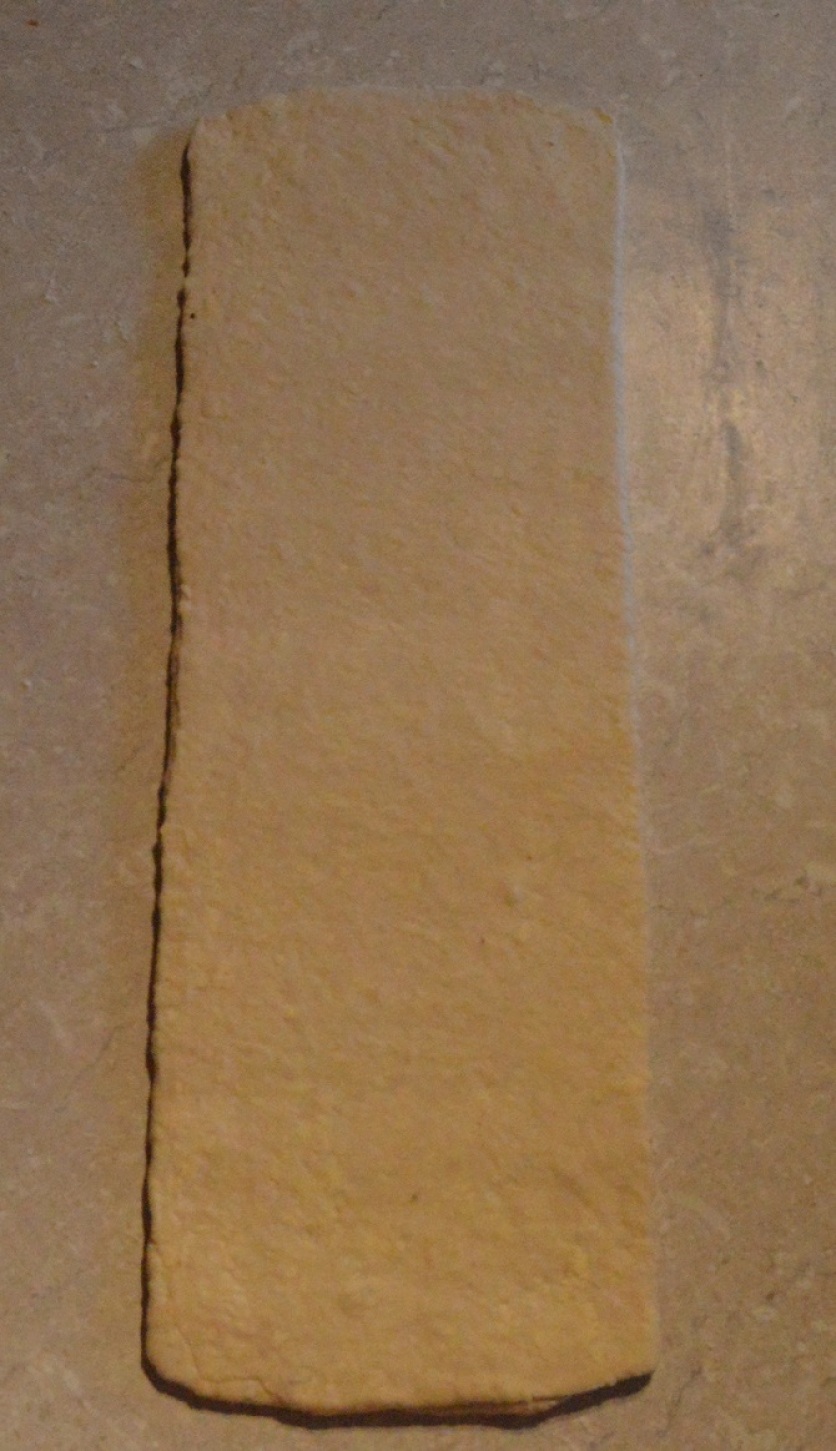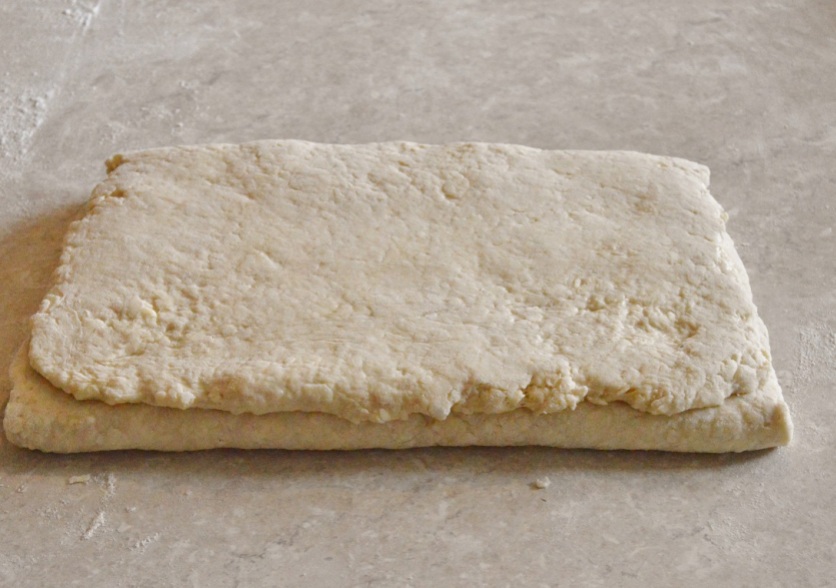A batch of traditionally made croissants can take the best part of a weekend with all the resting and chilling in between the turns and at other stages.
Don’t get me wrong, making croissants this way is one of the top baking pleasures for me, but there are certainly times when effective shortcuts are called for. And this shortcut is certainly effective in that it gives excellent results and is easier to achieve than traditional croissants.
This quicker approach, using grated frozen butter, takes about 20 minutes to make up the laminated (layered) dough.
The dough then rests in the fridge before it can be use: this allows the gluten in the flour to relax making the rolling out for the shaping easier.
The quick dough
This method simply has the frozen butter grated into the flour at the start, for a more “all-in-one” dough. It then gets rolled out and folded a few times in quick succession. The frozen butter gets trapped between the flour, forming the layers.
I started making this quicker version as a boy, taking the idea from Delia Smith, who used this grated butter method in her recipe for sausage rolls: I simply added yeast and put in a few turns!
At the bottom of this post I have given photograph steps for incorporating the pastry in small chunks rather than grated: as in the rough-puff pastry method. This is still quicker and easier than the full-on traditional croissant dough, but is flakier than with this grated method.
A caveat!
Although this quicker dough can be made and laminated in about 20 minutes, the only caveat I would add is that the dough must remain cold while it is being made. So if you are making them in a warm kitchen, or if the dough starts to become at all sticky, be prepared to pop the dough in the freezer for about 15 minutes. On a cold day, though, I normally get all this done in one go.
The dough really does need to chill for a few hours after the 3 turns to allow it to relax, thereby making it easier to roll out for cutting and shaping.
This quick method versus the traditional method
With this grated butter method, you get slightly random layers and an interior that is not quite as open, but you still get very good, light flaky results. And this approach is certainly both easier and quicker than making a full-on croissant dough.
The photos on the left are the quicker croissants; the photos on the right show croissants made traditionally.
The traditional recipe for making croissants, which has full instructions and photographs for shaping (regardless of the dough you have made) is here.
The turns
With quicker croissants, I start with a book turn and then two envelope turns (see the recipe below for these turns). While I don’t often do a book turn with traditional croissants, putting in a book turn for quicker croissants gives extra layers in the dough which I think is needed as compensation for this very quick method.
Time scale
These are not by any means instant croissants, as the dough needs to rest in the fridge once the turns have been completed, as well as time for the shaped dough to prove, but the hands-on time for getting the dough made up and laminated is about 20 minutes.
For resting the dough: go for at least 2 hours for the dough to rest in the fridge, wrapped in clingfilm. I like to leave the dough overnight in the fridge for even better results.
For the proving (rising): you need an hour or two at room temperature once the dough has been shaped.
TOP TIP: keep a block of butter in the freezer so you can use it whenever you want to make these quick croissants
Recipe: quicker croissants – makes about 8
Dough:
- 350g strong white plain flour
- 10g dried “instant” yeast
- 7g fine sea salt
- 50g caster sugar
- 90ml cold water
- 90g cold semi-skimmed milk
- 250g unsalted best quality butter, frozen until very firm
To finish:
- egg yolk beaten with a little milk
————————
To make up the dough for laminating- which is almost quicker to make than to read this recipe:
(1) Mix the flour, sugar, yeast and salt together and grate the frozen butter into this mixture. Use your fingers to gently coat the butter strands in flour.
(2) Add the milk and most of the water and mix gently with a knife to form a soft but not sticky dough, trying not to crush the butter too much. Add more water if needed.
Laminate the dough:
(3) Lightly dust the dough and the work surface with flour. Roll out the dough thinly to a rectangle with sides about 15cm by 60cm: these measurements are just guidelines – you want a long, thin strip of dough that is about 4 times as long as it wide here. It will look quite rough initially but bear with it.
(4) Give it a book turn: with the short edge facing you, fold over the bottom and the top edge to meet in the middle and fold in half to give 4 layers of dough:
(5) Rotate the dough 90 degrees and roll out to a rectangle about 20cm by 60cm then go for two envelope turns* in succession, brushing off any excess flour at each stage and rotating 90 degrees after each turn.
* for each envelope turn, fold the bottom third of dough up and the top third over this (as in the photo below).
This is now the laminated dough which just needs to rest in the fridge for at least a few hours before using.
NB: if the dough starts to feel slightly warm or sticky at any point, pop it in the fridge for about 30 minutes to chill.
(6) Cover the dough loosely with clingfilm and chill for at least a couple of hours to relax it, which makes it much easier to roll out for the shaping.
Shape*:
(7) Roll out the dough to a long thin rectangle just over 20cm wide and 60cm long. Trim the edges with a sharp knife, cut into triangles with base about 12cm and height 20cm. Take a triangle and stretch the top third or so gently between your fingers to make them a little longer. Roll it up from the base, lightly stretching as you get near the tip and make sure the tip is underneath. Repeat with the other triangles.
(8) Place on baking trays lined with a double layer of greaseproof paper and pop inside a large bin liner. I usually stand a tall cup in there to prevent the plastic touching the dough.
*see my main croissants post for photos demonstrating the shaping of croissants and pains au chocolat.
Prove (rise):
(9) Leave to rise for a couple of hours until they look puffy and have a gentle wobble to them. Brush with the beaten egg yolk. In a cooler enviroment, this might take longer.
Bake:
(10) Place in an oven pre-heated to 175C (fan) and bake for about 20 minutes until well risen and golden. Turn down the temperature to about 160C after 15 minutes if they are looking too dark.
Other bakes using the quicker croissant dough
The recipes below are some of my favourite uses of quick croissant dough. And if you have a batch of dough made and frozen from earlier, even better!
Bitter orange pains au chocolat
Sticky orange and dark chocolate fillings in light, buttery pastry…what is not to love?
The recipe for these wonderful pastries, along with photos of the shaping, is here.
Croissaladière
This is my take on the classic pissaladière (anchovies, olives and slowly cooked onions….), using croissant dough as the base rather than bread dough.
Recipe for croissaladière.
Croissage rolls!
While sausage rolls made with a crisp, flaky pastry are a real comfort bake for me, using croissant dough instead of traditional pastry gives a heartier bite.
Peach Danish pastries
The simplest Danish pastries, also using a shortcut filling.
Recipe for peach Danish pastries
A shortcut croissant dough using chunks of butter rather than grated butter
The rough-puff pastry method is the method I use more than any other method when it comes to shortcut puff pastry. It is not as quick as the grated butter method above for croissants, but it gives a better structure and is still easier than making traditional croissants.
The proportions of the key ingredients (flour, butter, sugar, salt and water) are the same as above. You just add the butter in small chunks with the flour rather than grating it in and proceed in a similar way: rolling out the dough thinly and giving it 3 envelope folds with a 20- minute chilling in the freezer between each turn.
The photos below were for a shortcut croissant dough using this method: I had also included cocoa and ginger in the dough for that particular bake:


























Interesting method. Looks amazing! 🙂
LikeLike
Thank you. I love shortcuts when they work!
LikeLike
Absolutely! 😀
LikeLike
I can’t wait to try this! Thanks for explaining the difference between the traditional method and this faster version.
LikeLike
A pleasure. I hope you enjoy them: they are quite addictive!
LikeLike
Thank you so much. The fridge it will be!
Another question please: Would regular all purpose / plain flour give acceptable results? I don’t get strong flours where I live.
Thank you again for your wonderful explanations across all recipes. 🙂
LikeLiked by 1 person
Love the small chunkes tip! I usually cut the butter into tiny little pieces for pie crust but never thought to do that with puff pastry and I’m not keen on grating the butter but I have…thanks!
LikeLiked by 1 person
This was my 4th croissant recipe after 3 failures. I enjoyed making them, found the resting times useful to do other things like walk the dog! Going to experiment with the butter by cutting it into blocks which will go through my Bamix grating appliance before freezing, then I can gradually gently blend piece by piece. Thank you for restoring my culinary confidence!
LikeLike
Hi I am so pleased you like the recipe. It’s a good one for shortcut croissants
LikeLike
What is strong white flour? All purpose? Bread? Pastry?
LikeLike
it is bread flour: in the UK we call it “strong white” – so it has a higher % of protein in there.
LikeLike
Love it ! I’ll try il, I’m in the caribbean so hot in here lol
LikeLiked by 1 person
I am excited to try this. I am in a hot country so wondered if it matters if butter melts while the croissants are proving for an hour or so? Will there still be flaky layers in the croissant?
LikeLike
If it’s too hot the butter is melting and, heaven forbid, potentially oozing, you can leave them covered in the fridge to slowly prove
LikeLike
Thank you so much. The fridge it will be!
LikeLike
Thank you so much! The fridge it will be.
Another question please: Will one get acceptable results by using regular all-purpose / plain flour? I don’t get strong flours where I live.
Thank you so much once again for all your detailed descriptions and help to novice bakers. 🙂
LikeLike
Although strong plain is best, standard plain will be fine
LikeLiked by 1 person